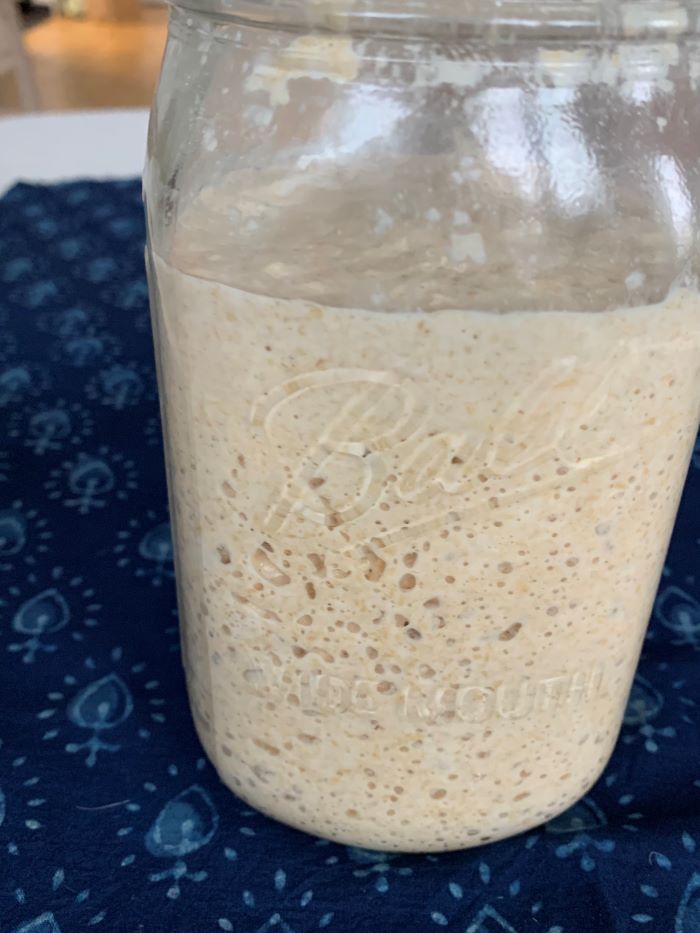Sourdough starter

Homegrown starter culture for sourdough bread
I strongly urge you to read my other post – The art of Sourdough Baking, before starting on this exciting journey of baking with sourdough and starting your own culture.
It is a truly magical experience to make such a great tasting bread with just 3 humble ingredients flour, water and salt.
To grow your own starter, you will need:
- Whole wheat flour
- water
- glass jar – 64 oz mason jar is perfect
- kitchen scales
- Lots of patience!
I highly recommend using kitchen scales for the starter as well as the bread making. However, if you do not have one, you can follow the below cup measure to g conversions:
1/4 cup all purpose flour/ bread flour/ maida is roughly 40g – loosely packed, leveled
1/4 cup whole wheat flour is roughly 32g – loosely packed, leveled
Procedure:

DAY 1:
mix 50 g flour and 50 g tepid water in a glass jar. cover lightly and keep in a warm spot for 24 hours.
DAY 2:
Not much will have changed – this is ok. Add another 50g flour and 50g tepid water to the same jar. mix it well and cover lightly. Leave in a warm spot to ferment for another 24 hours.
DAY 3:
The starter will start smelling slightly sweet at this point. You will have ~200g in the jar at this point. Discard half and add 100g fresh flour and 100g tepid water – mix well, cover lightly and leave in a warm spot to ferment for another 24 hours
DAY 4:
The strter will strat to smell sweet and acidic at this point – that’s a great sign! At this point you will have ~300g in the jar. Discard half and feel the starter with 150g flour and 150g tepid water. You know the drill!! – cover lightl and leave for 24 hrs to ferment
DAY 5:
The cuture will start bubbling and will have climbed the walls of the glass jar significantly. It rises and falls, so as long as you can see a mark on the glass jar, showing that it had risen to about double its level at some point, you are on track to making a great starter.
You have ~450g starter in the jar at this point. Discard 200g and feed with fresh 200g flour and 200g tepid water – cover and ferment for 24 hrs.
DAY 6:
You can really smell it at this point and it should have grown significantly bubbly. You have ~650g in the jar at this point. You will need to discard half of it and feed the starter with fresh water and flour.
Since, I did not want to discard so much, I decided to split mine in two jars (200 g each, discarded only the excess) from this point onward.
Each jar now has 200g starter, to each I fed 200g flour and 200g water. Cover and let sit for 24 hours.
DAY 7:
Both jars are full of beautifully fermented, ready-to-use starter. If you feel it hasn’t fermented enough (from the acidic smell, bubbly appearance, how much it climbed on the jar, etc) feel free to give it another day. Particularly, if the climate is cooler, would definitely not hurt to give it another day.

This is how it should look at the end of 7-8 days. I used whole wheat flour, so the texture looks grainy. If you used all purpose or a sifter wheat flour, yours will look smooth and that is completely fine.
To read more about sourdough baking basics and FAQ’s pleaseread my post – The art of sourdough baking.
After the week long wait for your natural yeast to grow, you are ready to bake bread!!
For the bread, follow the recipe here.
With my sourdough bread recipe you will use less than 200g of the starter per loaf. You can store the rest of the starter back in the fridge (with lid closed).
When you want to bake, Remove about 70g of starter from the refrigerator, let it come to roughly come to room temp. feed it with 70g tepid water and 70 g flour and let sit covered at room temperature for 24 hours. Now its ready to be used in your sourdough bread (Recipe here)
The starter gets a kickstart every time you feed it with fresh flour and water and the fermentation is accelerated because the naturak yeast in it has new food to digest. when the strter is stored in the fridge, this process slows down and feeding the yeast is not necessary.
It is a good idea to remove the refrigerated jar/s every once ina while and refresh the starter with fresh flour and water,. you can do this when the weather is good for fermentation or when you know you want to bake lots of bread!
Each sourdough starter is unique in the taste characteristics it yields in the bread that it is used in. Sourdough cultures can be preserved and propogated for years! As long as you are taking good care of your starter, once you get through the initial wait, you will always have ready-to-use starter in your kitchen!